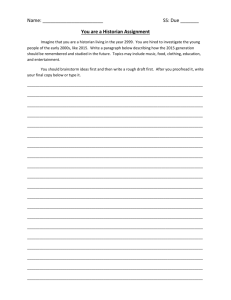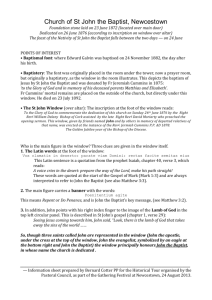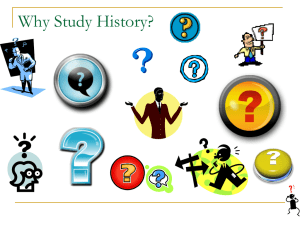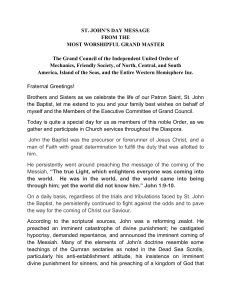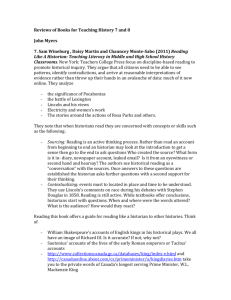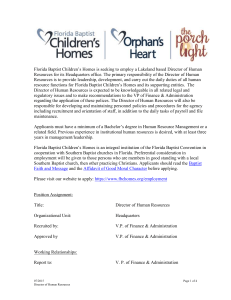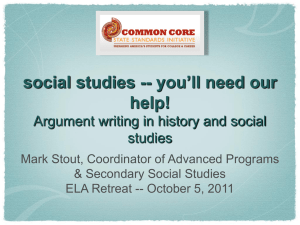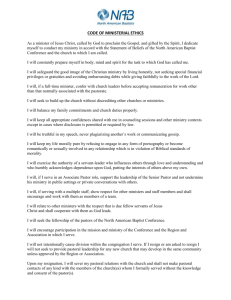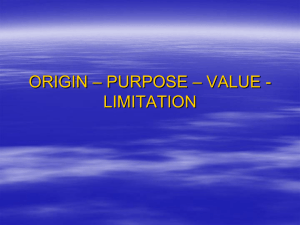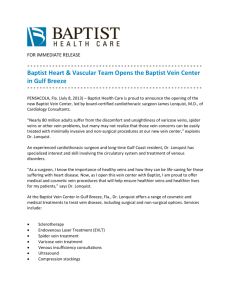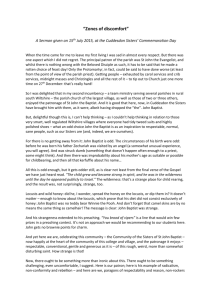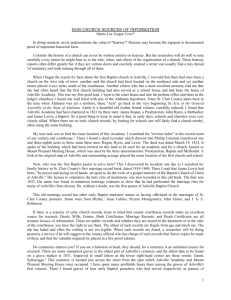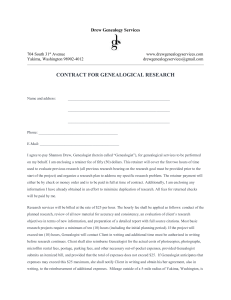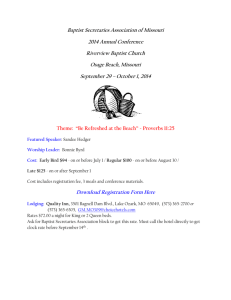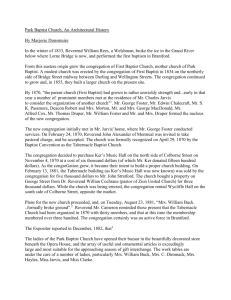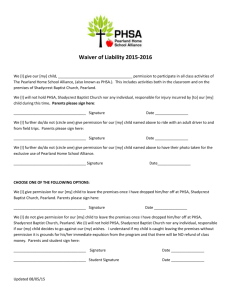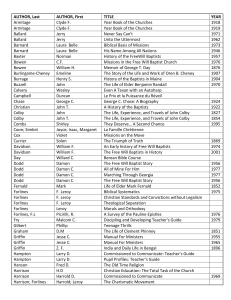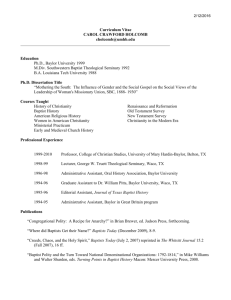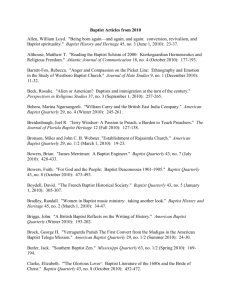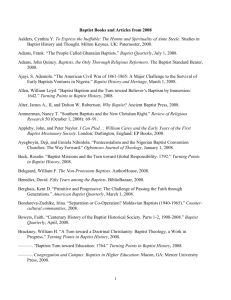WRITING BAPTIST HISTORY: USING GENEALOGICAL TOOLS
advertisement
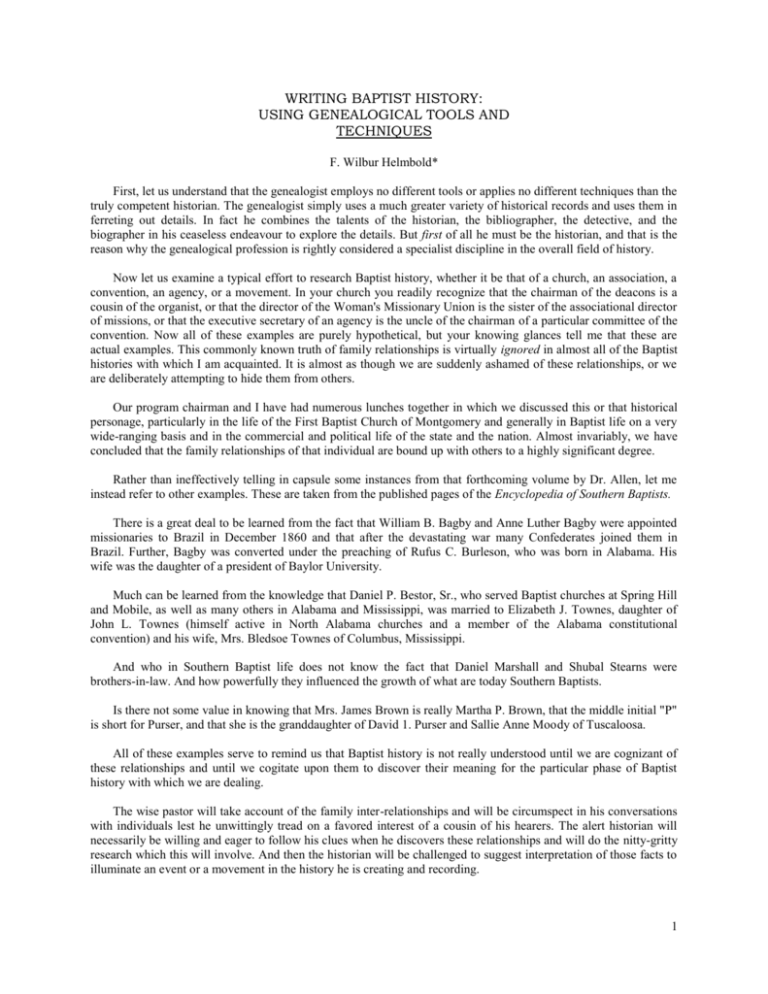
WRITING BAPTIST HISTORY: USING GENEALOGICAL TOOLS AND TECHNIQUES F. Wilbur Helmbold* First, let us understand that the genealogist employs no different tools or applies no different techniques than the truly competent historian. The genealogist simply uses a much greater variety of historical records and uses them in ferreting out details. In fact he combines the talents of the historian, the bibliographer, the detective, and the biographer in his ceaseless endeavour to explore the details. But first of all he must be the historian, and that is the reason why the genealogical profession is rightly considered a specialist discipline in the overall field of history. Now let us examine a typical effort to research Baptist history, whether it be that of a church, an association, a convention, an agency, or a movement. In your church you readily recognize that the chairman of the deacons is a cousin of the organist, or that the director of the Woman's Missionary Union is the sister of the associational director of missions, or that the executive secretary of an agency is the uncle of the chairman of a particular committee of the convention. Now all of these examples are purely hypothetical, but your knowing glances tell me that these are actual examples. This commonly known truth of family relationships is virtually ignored in almost all of the Baptist histories with which I am acquainted. It is almost as though we are suddenly ashamed of these relationships, or we are deliberately attempting to hide them from others. Our program chairman and I have had numerous lunches together in which we discussed this or that historical personage, particularly in the life of the First Baptist Church of Montgomery and generally in Baptist life on a very wide-ranging basis and in the commercial and political life of the state and the nation. Almost invariably, we have concluded that the family relationships of that individual are bound up with others to a highly significant degree. Rather than ineffectively telling in capsule some instances from that forthcoming volume by Dr. Allen, let me instead refer to other examples. These are taken from the published pages of the Encyclopedia of Southern Baptists. There is a great deal to be learned from the fact that William B. Bagby and Anne Luther Bagby were appointed missionaries to Brazil in December 1860 and that after the devastating war many Confederates joined them in Brazil. Further, Bagby was converted under the preaching of Rufus C. Burleson, who was born in Alabama. His wife was the daughter of a president of Baylor University. Much can be learned from the knowledge that Daniel P. Bestor, Sr., who served Baptist churches at Spring Hill and Mobile, as well as many others in Alabama and Mississippi, was married to Elizabeth J. Townes, daughter of John L. Townes (himself active in North Alabama churches and a member of the Alabama constitutional convention) and his wife, Mrs. Bledsoe Townes of Columbus, Mississippi. And who in Southern Baptist life does not know the fact that Daniel Marshall and Shubal Stearns were brothers-in-law. And how powerfully they influenced the growth of what are today Southern Baptists. Is there not some value in knowing that Mrs. James Brown is really Martha P. Brown, that the middle initial "P" is short for Purser, and that she is the granddaughter of David 1. Purser and Sallie Anne Moody of Tuscaloosa. All of these examples serve to remind us that Baptist history is not really understood until we are cognizant of these relationships and until we cogitate upon them to discover their meaning for the particular phase of Baptist history with which we are dealing. The wise pastor will take account of the family inter-relationships and will be circumspect in his conversations with individuals lest he unwittingly tread on a favored interest of a cousin of his hearers. The alert historian will necessarily be willing and eager to follow his clues when he discovers these relationships and will do the nitty-gritty research which this will involve. And then the historian will be challenged to suggest interpretation of those facts to illuminate an event or a movement in the history he is creating and recording. 1 The historian in effect must become at least an amateur genealogist if he is going to successfully follow the clues regarding these relationships. To do so he must delve into the original source records which are not commonly consulted by ordinary historians. He must search through the census records of the families with whom he is concerned, not missing points regarding the birthplaces, the proximity of neighboring families, the property values of the families, or the number of slaves which the family holds. He may search for deeds and probate records in the county courthouse. He may examine the records of marriage licenses in the courthouse. He may need to investigate the available pension and service records of an individual. He may consult records of cemeteries, of sister churches, of affiliates such as associations, conventions and agencies. He may explore the possibilities in manuscript collections of related families, related agencies, related businesses, and related governmental bodies. He must not be trapped by "tunnel vision", simply concerned about his particular church, or his association, or his state. It is important that the historian broaden his horizon so that he sees the larger picture. At the same time that he is looking at the larger picture, he must not ignore the burrowings into the depths of things right before his eyes. He must constantly ask the question, "why." No simple recording of the facts lying on the surface for his history will do. He must dig deeper, much deeper, and yet he must also look abroad much wider. Only as he himself understands the why of the thing can he effectively communicate the real truth as he writes the history. In the beginning of this paper, I mentioned that one of the talents of the genealogist is that of the bibliographer. One must become aware of the vast range of recorded knowledge to do a competent job as a genealogist. Perhaps my own interest in bibliography for all the years since I was a student at old Howard College induces me to emphasize this point. Bibliography is said to be the "queen of the sciences." Whatever agreement we have with that claim, the fact remains that he who does not know of the existence of the wheel is destined to attempt an effort to invent the wheel, as foolish as that effort is. Knowledge lies buried in thousands of repositories. One needs to know of the existence of the knowledge, of where it may be found, and of what body of material within which it may be contained. That in essence is bibliography. Let us be encouraged then to expand our thinking, broaden our horizons, and deepen our commitment to dig for the truth and to tell the truth. Truth then becomes luminescent and shed its shining rays into not only our own hearts but into those of our readers and hearers as well. *Mr. Helmbold was editor of this publication at the time this article was published. He is now retired and is librarian emeritus and curator emeritus. "It's not what you know, but who you know, that counts," and "Blood is thicker than water" are two pieces of folk wisdom that have some relevance in church history. Why was so-and-so elected chairman of a certain committee? The answer might be found in genealogy, according to F. W. Helmbold. The explanation of some puzzles can be found often by determining who is kin to whom in a church. One of the foremost genealogical educators in this nation, Mr. Helmbold correctly urges researchers to keep alert to family relationships as a clue to why the church functions as it does. Lee N. Allen 2
